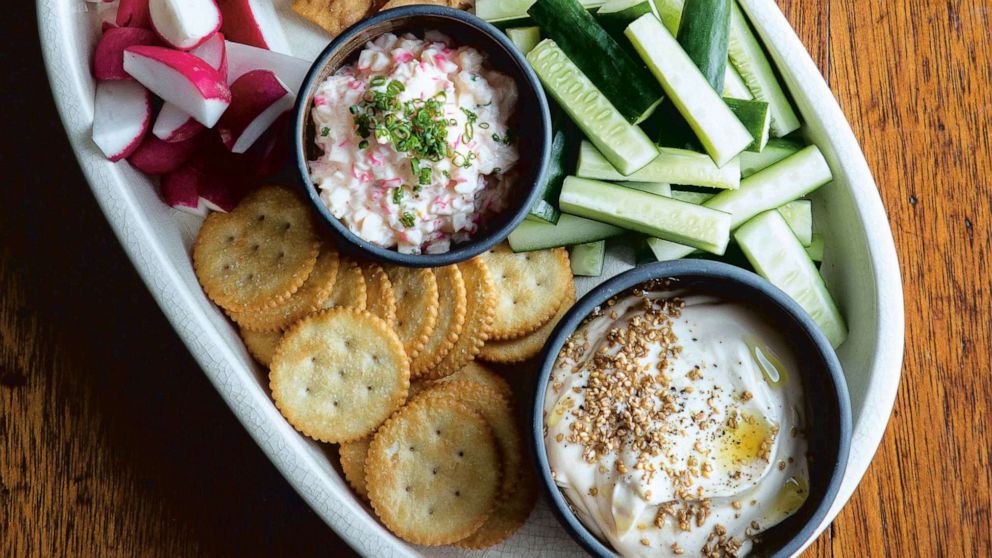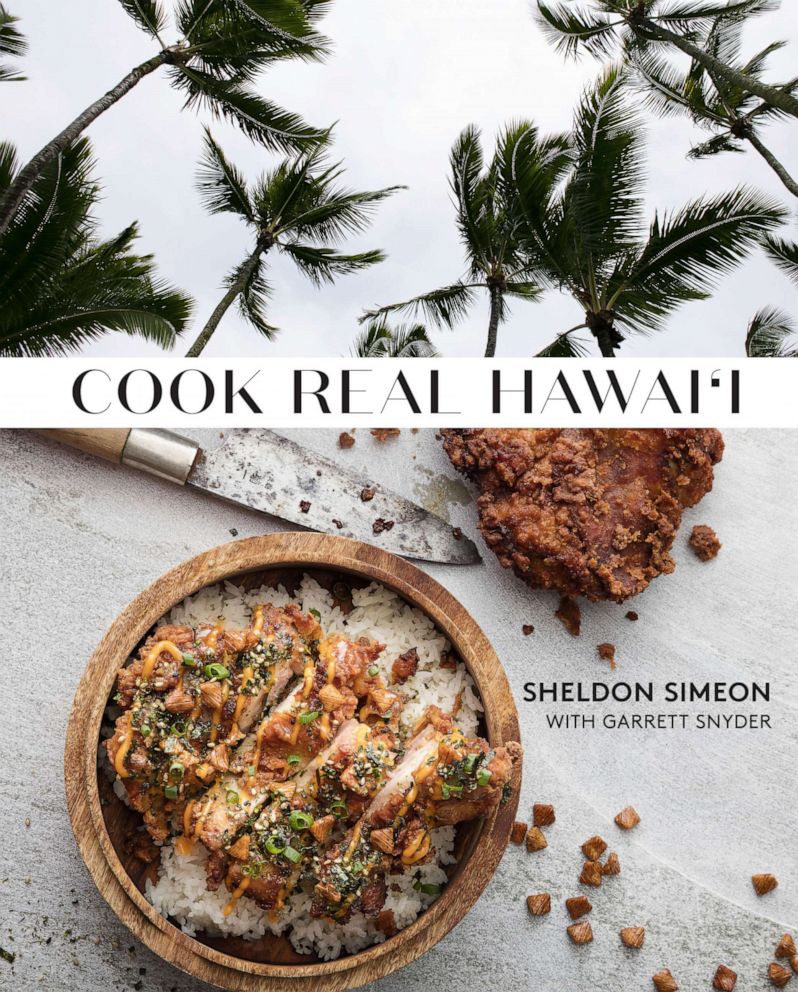How to make 2 Hawaiian recipes, plus a haiku about Spam

Celebrity chef, restaurant owner and Hawaii native Sheldon Simeon has added another title to his impressive resume: Cookbook author.
The author of the newly released "Cook Real Hawaii," Simeon joined "GMA" to share two recipes from the book that celebrates the food, flavors and culture of true Hawaii cuisine.

Spam Masubi
Makes 6
Perhaps you’ve heard somewhere that Hawai‘i eats a lot of Spam. We love the stuff with the whole of our hearts, ever since it was introduced here during the rationing days of WWII. We eat more of it per capita than any place on earth besides Guam. Here’s a haiku someone wrote on the Internet about Spam that sums up our (or at least my) collective feelings:
Can of metal, slicksoft center, so cool, moisteningI yearn for your salt
The porcine saltiness, the impossibly emulsified texture, the infinite shelf life—these are reasons why we add this humble king of canned luncheon meat to fried rice, saimin, wontons, or somen salad. We slice it up, we saute it, we cook it with shoyu and sugar; we transform this gnarly industrial food scooped from a can into something beautiful and delicious.
No food allows Spam to shine brighter than musubi, a portable block of nori-wrapped rice that is sold at gas stations, corner shops, diners, gymnasiums, lunch wagons and takeout counters of all stripes. You’ll often see musubi stuffed with red hot dogs, mochiko chicken, egg omelets or teriyaki. But the Spam-filled kind is easily the most popular.
There are many differing techniques for preparing and wrapping Spam musubi. Without getting too technical up top, here are a few of my basic guidelines: 1. Cut your Spam thick so you can taste it (I prefer the reduced-sodium kind for its balanced taste). 2. Sear then glaze the Spam with shoyu and sugar before wrapping. 3. Make sure your rice is warm and your nori sheets are bone-dry. (And a musubi mold makes this easy, but you can use a Spam can. See Note.)
Ingredients
Neutral oil, for the skillet
1 (12-ounce) can 25% Less Sodium Spam, cut into 6 slices horizontally
1/4 cup shoyu (soy sauce)
1/4 cup sugar
2 tablespoons mirin
2 sheets sushi nori
4 cups cooked short-grain white rice, warm
2 teaspoons Furikake (optional)
Note: Musubi maker molds, which are rectangular plastic boxes open on the top and bottom, are available for a few bucks online. If you don’t have one, you can use the empty Spam can as a mold: Shape the rice into a block inside the can by firmly pressing it down with your fingers, then shake it from the can. Place the packed block of rice perpendicular to the nori strip and carefully wrap with the nori as directed.
Lightly coat the bottom of a skillet with oil and heat over medium heat. Fry the Spam.
slices until browned and crispy, 2 to 3 minutes per side. Remove from the heat and set aside on paper towels to drain.
Wipe out any excess oil from the pan. Add the shoyu, sugar, and mirin and stir to combine. Bring to a boil, then reduce the heat to low, return the cooked Spam slices to the pan and turn them to coat. Cook until a sticky glaze starts to form, about 1 minute. Remove the pan from the heat and let the Spam sit in the glaze until ready to use.
Toast the nori sheets by carefully waving them over a stove burner on low (this is easiest with gas; use tongs if needed) for 10 to 20 seconds until crisp and crackly, then cut each sheet into thirds lengthwise. (You can also toast them briefly in a hot oven, a minute or two, just until crisp.)
Prepare a bowl of warm water.
Lay a strip of nori on a clean surface. Moisten the lower half of the inside of a musubi mold (see note above) and place the mold perpendicular to the nori strip on the bottom third of the strip. Fill the mold with about 1/2 cup rice and press down very firmly and evenly until the rice is packed 3/4 inch high. Sprinkle the rice with furikake (if using). Top with a slice of Spam, making sure a little of the glaze carries over from the pan onto the rice.
Pull off the mold and wrap the musubi tightly in the nori strip by rolling it away from you as you would a sushi roll. Seal the edge of the nori with a dab of warm water if necessary (the moisture in the warm rice should do most of the work). Wipe off the mold with warm water and repeat with the remaining Spam and rice.
Serve immediately, or wrap in plastic wrap and save for later.
Kim Chee Dip
Serves 4 to 6
Hawai‘i loves its kim chee (and yes, we spell it that way rather than kimchi). Jars of the briny fermented cabbage are a fridge staple here, and local grocery stores sell bottles of what’s known as kim chee base: a concentrated sweet-spicy red sauce that you can pour over any salad or poke (think seaweed, tuna, squid) to turn it “kim chee style.
Kim chee also shows up as the star in kim chee dip, a common local dip that is usually served as a crowd-pleasing pupu. The basic components are chopped won bok (napa cabbage) kim chee, and a solid amount of cream cheese, which tames the punchy flavor and provides a distinct silkiness. The version at my restaurant is mostly traditional, with an extra touch of Parmesan and fried garlic for added savoriness. Depending on which brand you use (Halm’s, Kohala, and High Max are popular here), you might consider increasing the sweetness of your kim chee slightly to match our local ones.
I tend to pair this dip with whatever chip is available at the corner gas station; I haven’t found a bad combination yet. Try using it as a general spread, too: The iconic Hawai‘i chef Sam Choy has one recipe where he slathers it on a steak sandwich.
Ingredients
8 ounces cream cheese, at room temperature
1/4 cup sour cream
6 ounces cabbage kim chee, roughly chopped (about 3/4 cup), with juice reserved
1 teaspoon sugar, plus more as needed
1 tablespoon grated Parmesan cheese
2 teaspoons fresh lemon juice
1 teaspoon kochugaru (Korean chili flakes), plus more to taste
Kosher salt
1 tablespoon Fried Garlic (recipe follows below)
Wonton chips, crackers, Doritos (Cool Ranch preferred), Fritos, Tostitos, or any other available -ito, for serving
Directions
In a medium bowl, stir together the cream cheese and sour cream, adding kim chee juice as needed to achieve a smooth Velveeta-like texture. Fold in the chopped kim chee, sugar, Parmesan, lemon juice, and the kochugaru. Adjust the seasoning with salt and sugar to taste. Transfer the mixture to a serving bowl and top with the fried garlic and an extra sprinkle of kochugaru. Serve with chips.
Fried Garlic
Makes about 1 1/2 cups
8 ounces peeled garlic (about 1 1/2 cups or 25 cloves)
Neutral oil, for frying
Kosher salt
Preheat the oven to 250 degrees. Line a baking sheet with paper towels.
In a food processor, pulse the garlic until finely minced.
Fill a medium-width, deep-sided pot halfway with water and bring to a boil, then turn off the heat. Fill a large bowl with ice water. Transfer the garlic to a sieve and submerge in the hot water, blanching for about 2 minutes. Remove and dunk the garlic in the ice water until cooled, then drain well and spread evenly onto the lined baking sheet. Bake until the garlic is dry to the touch, 12 to 15 minutes.
While the garlic is drying, empty out the pot and dry well. Fill the pot with at least 2 inches of oil, making sure to leave a few inches of clearance from the top of the pot. Heat the oil over medium-high until it reaches 350 degrees (use a thermometer).
Have the baking sheet lined with paper towels at the ready. Add the garlic and fry until the bubbles begin to subside and the garlic turns golden and rises to the surface, 3 to 4 minutes. Transfer the fried garlic back to the paper towels and let cool completely. Season generously with salt, then transfer to a sealable container and store in a cool, dry place for up to 3 weeks. Reserve the garlic-flavored frying oil for future use.
Recipes reprinted with permission from "Cook Real Hawai'i."




